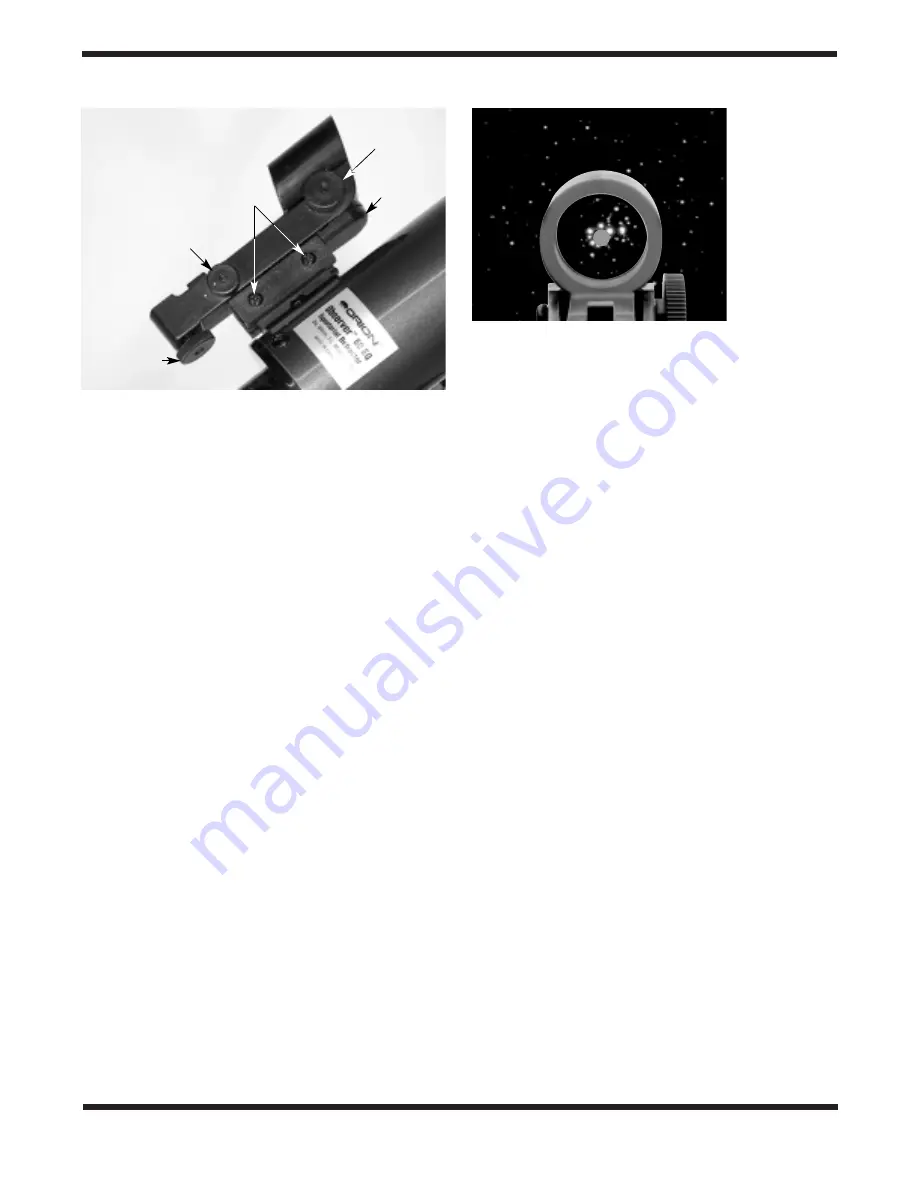
12
chimney and center it in the telescope’s eyepiece. Now, turn
the EZ Finder II on and look through it. The object will appear
in the field of view near the red dot.
Note: The image in the eyepiece of the Observer 60mm
will be reversed from left-to-right. This is normal for a
refractor telescope using a mirror star diagonal.
Without moving the telescope, use the EZ Finder II’s azimuth
(left/right) and altitude (up/down) adjustment wheels (Figure
5) to position the red dot on the object in the eyepiece.
When the red dot is centered on the distant object, check to
make sure that the object is still centered in the telescope’s
field of view. If not, recenter it and adjust the EZ Finder II’s
alignment again. When the object is centered in the eyepiece
and on the red dot, the EZ Finder II is properly aligned with
the telescope. Figure 6 shows how the view through the EZ
Finder may look while you are aligning it.
Once aligned, EZ Finder II will usually hold its alignment even
after being removed and remounted. Otherwise, only minimal
realignment will be needed.
Replacing the EZ Finder II Battery
Should the battery ever die, replacement 3-volt lithium batter-
ies are available from many retail outlets. Remove the old bat-
tery by inserting a small flat-head screwdriver into the slot on
the battery casing (Figure 5) and gently prying open the case.
Then carefully pull back on the retaining clip and remove the
old battery. Do not overbend the retaining clip. Then slide the
new battery under the battery lead with the positive (+) side
facing down and replace the battery casing.
5. Aligning the Equatorial
Mount
When you look at the night sky, you no doubt have noticed
that the stars appear to move slowly from east to west over
time. That apparent motion is caused by the Earth’s rotation
(from west to east). An equatorial mount (Figure 3a) is
designed to compensate for that motion, allowing you to easily
“track” the movement of astronomical objects, thereby keep-
ing them from drifting out of the telescope’s field of view while
you’re observing.
This is accomplished by slowly rotating the telescope on its
right ascension (R.A.) axis, using only the R.A. slow-motion
cable (7). But first the R.A. axis of the mount must be aligned
with the Earth’s rotational (polar) axis—a process called polar
alignment.
Understanding Polar Alignment
To understand what you will be doing when polar aligning,
look at Figure 7 and 8. The exaggerated telescope mount in
Figure 7 shows how you will be aligning the right ascension
axis (shown in Figure 3a) so that it is parallel to the Earth’s
axis and pointing towards the North Star (Polaris). Figure 8
shows what the polar alignment will mean in terms of your
location and other reference points.
The reason for polar alignment is a little tricky to understand;
since the Earth is rotating, stars are moving across the sky in
an arc pattern for most of the world. If you were standing at
the North or South Pole, the stars would move in a circular
pattern overhead, never rising or setting. If you were standing
on the equator, the stars would move in straight line over-
head. If you faced east, a star that rose directly in front of you
would set directly behind you in the West.
However, most of us live at a place on the Earth where the
stars rise at one point in the East, move across part of the
sky, and set at a different part of the Western horizon, if they
set at all. This means that if you were to use an ordinary tri-
pod (which moves in up/down and left/right motions) to mount
your telescope, you would have a hard time “tracking” stellar
objects. This is where an equatorial mount has the advantage,
it may take a little longer to set up, but the effort is worth it.
Don’t be intimidated by the setting circles and knobs, its actu-
ally easier to do than you might think! Once you’ve practiced
with it a few times, you’ll be able to set up the equatorial
mount easily.
Figure 6.
EZ Finder II
superimposes a
tiny red dot on the
sky, showing right
where the
telescope is
pointed.
Figure 5.
The EZ Finder II reflex sight
Power
knob
Azimuth
adjustment
wheel
Battery
cover
Altitude
adjustment
wheel
Security
screws




































